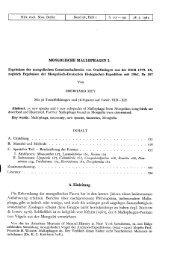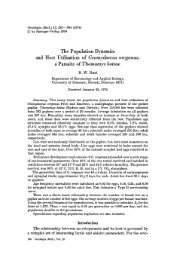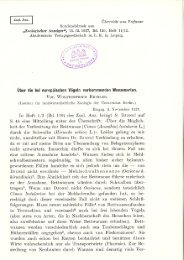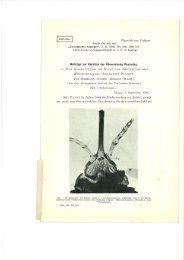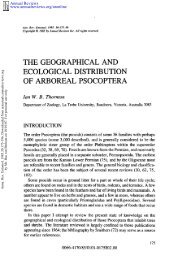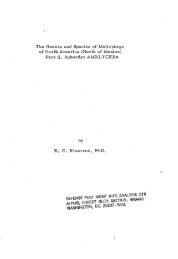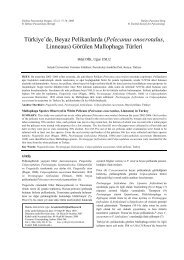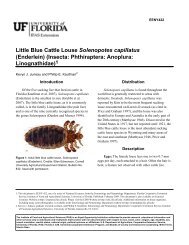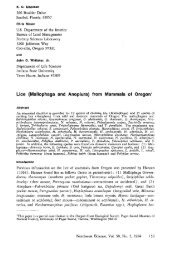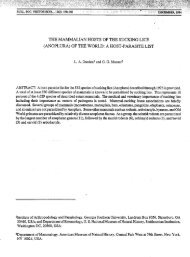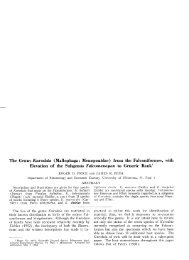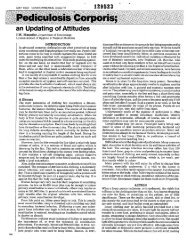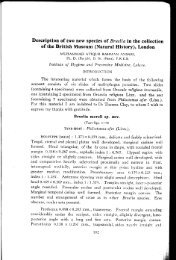Phthiraptera (Amblycera and Anoplura) parasites of the Family ...
Phthiraptera (Amblycera and Anoplura) parasites of the Family ...
Phthiraptera (Amblycera and Anoplura) parasites of the Family ...
Create successful ePaper yourself
Turn your PDF publications into a flip-book with our unique Google optimized e-Paper software.
118<br />
L Moreno Salas et al.: <strong>Phthiraptera</strong> <strong>parasites</strong> <strong>of</strong> rodents from Chile<br />
origin for Aconaemys <strong>and</strong> Octodon on <strong>the</strong> one<br />
h<strong>and</strong> <strong>and</strong> for Ctenomys on <strong>the</strong> o<strong>the</strong>r. The second<br />
could be <strong>the</strong> result <strong>of</strong> a secondary colonization,<br />
contemporary or extemporaneous, <strong>of</strong> members<br />
<strong>of</strong> <strong>the</strong> taxon that finally led to Aconaemys <strong>and</strong><br />
Octodon from a Ctenomyidae lineage. Both Gyropus<br />
elongatus <strong>and</strong> G. distinctus would not be sister<br />
species but ra<strong>the</strong>r species derived from a common<br />
trunk that share a convergent body shape.<br />
Indeed <strong>the</strong> hosts known for both species are<br />
allopatric. The two known hosts for Gyropus<br />
distinctus, Octodon degus, <strong>and</strong> O. lunatus, are<br />
partially sympatric in <strong>the</strong> central region <strong>of</strong> Chile<br />
(REDFORD & EISENBERG 1992), but <strong>the</strong>y do not<br />
have similar habits. Octodon lunatus apparently<br />
is less fossorial <strong>and</strong> inhabits areas that are more<br />
humid <strong>and</strong> densely shrubbed than O. degus,<br />
<strong>the</strong>refore water availability might be an important<br />
factor in <strong>the</strong> distribution <strong>of</strong> both species (CON-<br />
TRERAS et al. 1987). Never<strong>the</strong>less, <strong>the</strong> environmental<br />
<strong>and</strong> behavioral separation seems not to<br />
have influenced <strong>the</strong> differentiation <strong>of</strong> both populations<br />
<strong>of</strong> Gyropus, which are morphologically<br />
indistinguishable, <strong>and</strong> <strong>the</strong>refore considered <strong>the</strong><br />
same species. The only known host for Gyropus<br />
elongatus, Aconaemys fuscus, exhibits a great<br />
environmental tolerance, <strong>and</strong> is found from<br />
steppes <strong>and</strong> subxeric grassl<strong>and</strong>s to forests <strong>of</strong><br />
Noth<strong>of</strong>agus <strong>and</strong> Araucaria <strong>of</strong> <strong>the</strong> central Andes<br />
<strong>of</strong> Chile <strong>and</strong> Argentina (REDFORD & EISENBERG<br />
1992). It is semifossorial (CONTRERAS et al. 1987)<br />
<strong>and</strong> allopatric with respect to both species <strong>of</strong><br />
Octodon. This allopatry also would have contributed<br />
to <strong>the</strong> genetic isolation <strong>of</strong> this species <strong>of</strong><br />
Gyropus in comparison to G. distinctus, <strong>and</strong> it<br />
only lives on Abrothrix longipilis <strong>and</strong> Notiomys<br />
valdivianus (REDFORD & EISENBERG 1992). Both<br />
<strong>the</strong>se sigmodontine rodents are hosts only for<br />
species <strong>of</strong> Hoplopleura ENDERLEIN, 1904 (<strong>Anoplura</strong>:<br />
Hoplopleuridae). Gyropus parvus (EWING,<br />
1924) is closely associated with <strong>the</strong> C. mendocinus<br />
group <strong>and</strong> <strong>the</strong> Patagonian species. This<br />
suggests that Gyropus parvus is part <strong>of</strong> an ancestral<br />
lineage that derived exclusively from <strong>the</strong><br />
western <strong>of</strong>fspring <strong>of</strong> Ctenomys. Its presence in<br />
populations <strong>of</strong> <strong>the</strong> Ctenomys mendocinus-<br />
Patagonian species is consistent with <strong>the</strong> inferred<br />
evolutionary history <strong>of</strong> this genus. In turn its<br />
presence in Ctenomys talarum might be due to<br />
secondary infestations at <strong>the</strong> expense <strong>of</strong> species<br />
<strong>of</strong> <strong>the</strong> C. mendocinus group that are partially<br />
sympatric with it. Alternatively, it might be a normal<br />
component <strong>of</strong> Ctenomys talarum, given <strong>the</strong><br />
taxonomic proximity <strong>of</strong> C. talarum with species<br />
<strong>of</strong> <strong>the</strong> C. mendocinus group. Suggestively, Gyropus<br />
parvus is absent in some species <strong>of</strong> <strong>the</strong><br />
eastern subgroup <strong>of</strong> <strong>the</strong> Ctenomys mendocinus<br />
group, which is parasitized primarily by C. rionegrensis.<br />
Literature<br />
CASTRO, D. C. & A. CICCHINO (2002): Las especies de los<br />
géneros Gyropus NITZSCH, 1818 (<strong>Phthiraptera</strong>:<br />
Gyroponidae) parásitas de Octodontidae (Mammalia:<br />
Rodentia). - Rev. Chil. Hist. Nat. 75 (2), 293-298.<br />
- , - & J. C. TORRES-MURA (1987): Estudio descriptivo<br />
y comparativo de Gyropus parvus (Mallophaga),<br />
parásito de roedores Octodontoideos. - Anales del<br />
Museo de Historia Natural de Valparaíso (Chile) 18,<br />
41-45.<br />
- & A. GONZÁLEZ (1997): Las especies del genero<br />
Hoplopleura ENDERLEIN, 1904 (<strong>Phthiraptera</strong>, Insecta)<br />
parasitas de roedores de la Región Neotropical. -<br />
Papeis Avulsos Zool. 40 (13), 203-215.<br />
- & D. VERZI (2002): A new species <strong>of</strong> Ferrisella<br />
(<strong>Phthiraptera</strong>, <strong>Anoplura</strong>, Hoplopleuridae) parasitic<br />
on <strong>the</strong> desert-adapted rodent Tympanoctomys barrerae<br />
(Rodentia, Octodontidae). - Rudolstädter nat.hist.<br />
Schr. 9, 113-123.<br />
CONTRERAS, L. C., J. C. TORRES-MURA & J. YÁÑEZ (1987):<br />
Biogeography <strong>of</strong> octodontid rodents: an eco-evolutionary<br />
hypo<strong>the</strong>sis. - Fieldiana Zoology, n. ser., 39,<br />
401-411.<br />
FERRIS, G. F. (1951): The sucking lice. - Mem. Pac.<br />
Coast Entomol. Soc. (San Francisco) 1; 320 pp.<br />
PALMA, R. (1978): Slide-mounting <strong>of</strong> lice: a detailed<br />
description <strong>of</strong> <strong>the</strong> Canada balsam technique. - New<br />
Zeal<strong>and</strong> Entomologist 6 (4), 432-436.<br />
PRICE, R. D. & R. TIMM (2000): Review <strong>of</strong> <strong>the</strong> chewing<br />
louse genus Abrocomophaga (<strong>Phthiraptera</strong>: <strong>Amblycera</strong>),<br />
with description <strong>of</strong> two new species. - Proc.<br />
Biol. Soc. Washington 113 (1), 210-217.<br />
REDFORD, K. H. & J. F. EISENBERG (1992): Mammals <strong>of</strong><br />
<strong>the</strong> Neotropics. Volume 2: The Sou<strong>the</strong>rn Cone. Chile,<br />
Argentina, Uruguay <strong>and</strong> Paraguay. - Chicago (University<br />
<strong>of</strong> Chicago Press); 430 pp.<br />
SPORTORNO, A. & L. WALKER (2000): Origen y evolución<br />
de los mamíferos chilenos. Pp. 217-227. - In: Manual<br />
de Mamíferos de Chile. CEA Ediciones, Valdivia,<br />
464 pp.<br />
WERNECK, F. L. (1948): Os Mallóphagos de mammíferos.<br />
Parte I: <strong>Amblycera</strong> e Ischnocera (Philopteridae e parte<br />
de Trichodectidae). - Río de Janeiro (Revista Brasileira<br />
de Biologia); 243 pp.<br />
- (1951): Notas sôbre malófagos (Gyropidae). - Revista<br />
Brasileira de Biologia 11 (3), 303-313.<br />
WOODS, C. A. (1982): The history <strong>and</strong> classification <strong>of</strong><br />
South American hystricognath rodents: reflections<br />
on <strong>the</strong> far away <strong>and</strong> long ago. - Special Publication<br />
Series, University <strong>of</strong> Pittsburgh 6, 377-392.



